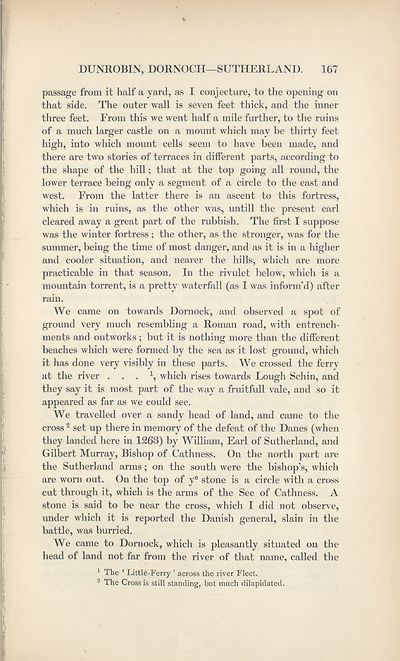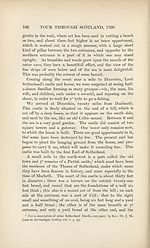Series 1 > Tours in Scotland 1747, 1750, 1760
(254) Page 167
Download files
Complete book:
Individual page:
Thumbnail gallery: Grid view | List view

DUNROBIN, DORNOCH—SUTHERLAND. 167
passage from it half a yard, as I conjecture, to the opening on
that side. The outer wall is seven feet thick, and the inner
three feet. From this we went half a mile further, to the ruins
of a much larger castle on a mount which may be thirty feet
high, into which mount cells seem to have been made, and
there are two stories of terraces in different parts, according to
the shape of the hill; that at the top going all round, the
lower terrace being only a segment of a circle to the east and
west. From the latter there is an ascent to this fortress,
which is in ruins, as the other was, untill the present earl
cleared away a great part of the rubbish. The first I suppose
was the winter fortress ; the other, as the stronger, was for the
summer, being the time of most danger, and as it is in a higher
and cooler situation, and nearer the hills, which are more
practicable in that season. In the rivulet below, which is a
mountain torrent, is a pretty waterfall (as I was inform’d) after
rain.
We came on towards Dornock, and observed a spot of
ground very much resembling a Roman road, with entrench¬
ments and outworks; but it is nothing more than the different
beaches which were formed by the sea as it lost ground, which
it has done very visibly in these parts. We crossed the ferry
at the river 1, which rises towards Lough Schin, and
they say it is most part of the way a fruitfull vale, and so it
appeared as far as we could see.
We travelled over a sandy head of land, and came to the
cross 2 set up there in memory of the defeat of the Danes (when
they landed here in 1263) by William, Earl of Sutherland, and
Gilbert Murray, Bishop of Cathness. On the nortli part are
the Sutherland arms; on the south were the bishop’s, which
are worn out. On the top of ye stone is a circle with a cross
cut through it, which is the arms of the See of Cathness. A
stone is said to be near the cross, which I did not observe,
under which it is reported the Danish general, slain in the
battle, was burried.
We came to Dornock, which is pleasantly situated on the
head of land not far from the river of that name, called the
1 The ‘ Little-Ferry ’ across the river Fleet.
2 The Cross is still standing, but much dilapidated.
passage from it half a yard, as I conjecture, to the opening on
that side. The outer wall is seven feet thick, and the inner
three feet. From this we went half a mile further, to the ruins
of a much larger castle on a mount which may be thirty feet
high, into which mount cells seem to have been made, and
there are two stories of terraces in different parts, according to
the shape of the hill; that at the top going all round, the
lower terrace being only a segment of a circle to the east and
west. From the latter there is an ascent to this fortress,
which is in ruins, as the other was, untill the present earl
cleared away a great part of the rubbish. The first I suppose
was the winter fortress ; the other, as the stronger, was for the
summer, being the time of most danger, and as it is in a higher
and cooler situation, and nearer the hills, which are more
practicable in that season. In the rivulet below, which is a
mountain torrent, is a pretty waterfall (as I was inform’d) after
rain.
We came on towards Dornock, and observed a spot of
ground very much resembling a Roman road, with entrench¬
ments and outworks; but it is nothing more than the different
beaches which were formed by the sea as it lost ground, which
it has done very visibly in these parts. We crossed the ferry
at the river 1, which rises towards Lough Schin, and
they say it is most part of the way a fruitfull vale, and so it
appeared as far as we could see.
We travelled over a sandy head of land, and came to the
cross 2 set up there in memory of the defeat of the Danes (when
they landed here in 1263) by William, Earl of Sutherland, and
Gilbert Murray, Bishop of Cathness. On the nortli part are
the Sutherland arms; on the south were the bishop’s, which
are worn out. On the top of ye stone is a circle with a cross
cut through it, which is the arms of the See of Cathness. A
stone is said to be near the cross, which I did not observe,
under which it is reported the Danish general, slain in the
battle, was burried.
We came to Dornock, which is pleasantly situated on the
head of land not far from the river of that name, called the
1 The ‘ Little-Ferry ’ across the river Fleet.
2 The Cross is still standing, but much dilapidated.
Set display mode to:
![]() Universal Viewer |
Universal Viewer | ![]() Mirador |
Large image | Transcription
Mirador |
Large image | Transcription
Images and transcriptions on this page, including medium image downloads, may be used under the Creative Commons Attribution 4.0 International Licence unless otherwise stated. ![]()
| Scottish History Society volumes > Series 1 > Tours in Scotland 1747, 1750, 1760 > (254) Page 167 |
|---|
| Permanent URL | https://digital.nls.uk/126605805 |
|---|
| Attribution and copyright: |
|
|---|
| Description | Over 180 volumes, published by the Scottish History Society, containing original sources on Scotland's history and people. With a wide range of subjects, the books collectively cover all periods from the 12th to 20th centuries, and reflect changing trends in Scottish history. Sources are accompanied by scholarly interpretation, references and bibliographies. Volumes are usually published annually, and more digitised volumes will be added as they become available. |
|---|


